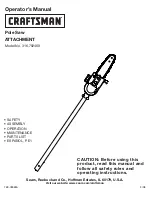
- 8 -
TYPE OF CUT
●
Contour cutting is done by guiding workpiece free-
handed to produce curved shapes.
●
Bevelled cutting is done by tilting saw table and using
proper work guide method.
●
Regardless of which work guiding method is used, a
workpiece which overhangs table by more than 5” needs
proper support.
CONTOUR SAWING
●
When contour sawing, use both hands to keep workpiece
flat against table and guided along
desired path.
●
Avoid positioning hands in line with blade. If hands slip,
they could contact blade.
●
Try to stand to front of the saw and use hands over the
portion of table that is to right of blade and before cut.
●
Cut small corners by sawing around them. Saw to
remove scrap until desired shape is obtained.
BEVEL CUTTING
●
Perform bevel cutting by tilting table to desired degree.
●
Unlock table by loosening locking handle located on the
backside of the unit.
●
Tilt table to desired position by rotating knob.
●
Lock table in position by tightening locking handle.
MITER GAUGE (Fig.13)
Use miter gauge for securing and holding workpiece at
desired angle to preduce angled cuts. Use scale to adjust
gauge to desired angle.
WARNING:
Never use miter gauge and rip fence at the
same time. The blade might bind in the workpiece. Operator
could be injured and/or workpiece could be damaged.
PUSH STICK
When cutting the smaller workpieces, you can operate by
using the push stick for your safety.
BLADE CLEANING BRUSH
Make sure that brush is in contact with blade to properly
remove foreign particles from drive wheel.
MAINTENANCE
WARNING:
Make certain that unit is disconnected from
power source before attempting to service or remove any
component.
CLEANING
●
Keep machine and workshop clean. Do not allow
sawdust to accumulate on band saw.
●
Keep wheels clean. Debris on wheels will cause poor
tracking and blade slippage.
●
Keep mechanisms and threaded or sliding surfaces
clean and free of foreign particles.
●
Operate band saw with a dust collector to minimize clean
up.
LUBRICATION
●
The shielded ball bearings are permanently lubricated
and require no further lubrication.
●
Small amounts of machine oil can be applied to belt
tension mechanisms and threaded or sliding surfaces.
●
Occasionally apply a coat of paste wax to tabletop to
keep it slick and corrosion free.
KEEP BAND SAW IN REPAIR
●
If power cord is worn of cut in any way, have it replaced.
●
Replace any damaged or missing part.
●
Use parts list to order parts.
Summary of Contents for BS-230
Page 1: ...BS 230 ...
Page 3: ... 2 Rubber Feet Additional Support Bolt 1 2 Wing Nut 3 4 6 Fence Clamp 5 6 ...
Page 5: ... 4 Miter gauge 13 ...
Page 12: ... 11 ...






























